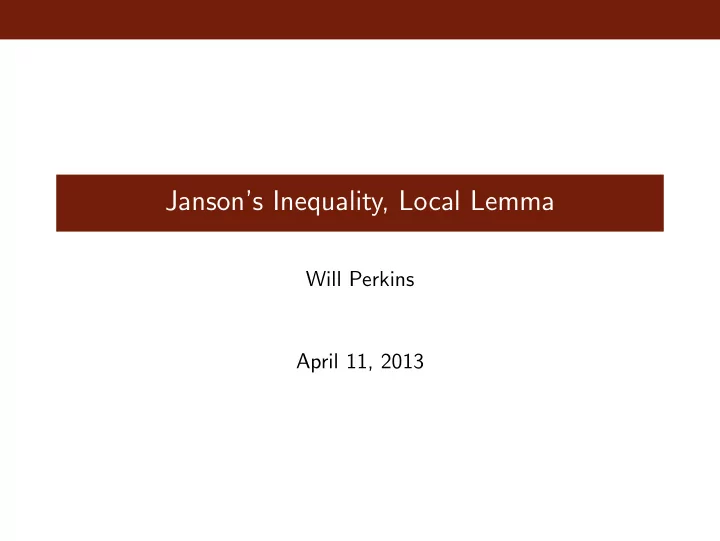

Janson’s Inequality, Local Lemma Will Perkins April 11, 2013
Janson’s Inequality First a detour back to Poisson convergence. HW problem (modified): If p = n − 2 / 3 (log n ) 1 / 3 , show that the number of vertices that are not in any triangle has a Poisson distirbution. It’s tricky enough just to compute the expectation.
Janson’s Inequality Setting: Large ‘ground set’ R , take a random set S ⊂ R where each r ∈ R is in S with probability p r independently. Let { A 1 , . . . A m } be a collection of subsets of R . And let B i be the ‘bad event’ that A i ⊆ S - i.e. all elements of A i appear in the random set. We want bounds on the probability that no bad event happens.
Janson’s Inequality What if all the A i ’s were disjoint? Then the bad events would be independent, and if X is the number of bad events, � Pr[ B c Pr[ X = 0] = i ] i We want to understand how dependent the events can be and still get a bound close to this.
Janson’s Inequality Let µ = E X . � µ = Pr[ B i ] i Notice � Pr[ B c i ] ≤ e − µ i (from the inequality 1 − x ≤ e − x ) and often we will have � Pr[ B c i ] ∼ e − µ i
Janson’s Inequality What about dependencies? Let i ∼ j if A i and A j intersect (i.e. B i and B j are dependent). Define � ∆ = Pr[ B i ∧ B j ] i ∼ j Here the sum is over ordered pairs i , j .
Janson’s Inequality Theorem (Janson’s Inequality) With the set-up as above, � Pr[ B c i ] ≤ Pr[ X = 0] ≤ e − µ +∆ / 2 i
Example A quick example: What is the probability that there are no triangles in G ( n , p ) when p = n − 4 / 5 ? With Chebyshev we would get something. We can’t apply Chernoff bounds because the triangles are not independent (we could look at a set of disjoint triangles but there are not enough of them). 1) Check that the above set-up applies. 2) � n � p 3 ∼ n 3 / 5 / 6 µ = 3
Example � Pr[ B i ∧ B j ] =? ∆ = i ∼ j Fix a triangle. There are 3( n − 3) triangles that share an edge with it. The probability that both triangles are present is p 5 . So � n � 3( n − 3) p 5 ∼ n 4 p 5 / 2 ∆ = 3 Janson’s inequality gives: (1 − p 3 )( n 3 ) ≤ Pr[ X = 0] ≤ e − ( n 3 ) p 3 + n 4 p 5 / 2
Example Note that for p = n − 4 / 5 , n 4 p 5 = o ( n 3 p 3 ), so Pr[ X = 0] ∼ e − n 3 p 3 / 6 = e − n 3 / 5 / 6 This ‘works’ up until n 3 p 3 = n 4 p 5 , i.e. p = n − 1 / 2 .
Lovasz Local Lemma Here’s another nice probabilistic tool. A simple observation: If a finite collection of events is independent and each has probability less than 1, then there is a positive probability that none of the events happen. But what if the events have some dependence?
Lovasz Local Lemma Theorem Let A 1 , . . . A n be events with a dependency graph that has maximum degree d. Suppose Pr[ A i ] ≤ p for all i. Then if ep ( d + 1) ≤ 1 there is a positive probability that no events occur.
Example Theorem Any k-CNF formula in which no variable appears in more than 2 k − 2 / k clauses is satisfiable.
Proof Claim: for any S ⊂ { 1 , . . . n } , 1 � ≤ A c Pr A i | j d + 1 j ∈ S The theorem follows from the claim by using the chain rule: �� � n � n � 1 � � A c A c ≥ Pr = 1 − Pr[ A i | j ] 1 − > 0 i d + 1 i i =1 j < i
Proof Proof of the claim: induction of the size of S . For S = ∅ , use the 1 condition p ≤ ( d +1) e . Now separate S into S 1 , coordinates j so that i ∼ j , and S 2 , coordinates j so that A i and A j are independent. Then write Pr[ A i ∩ � j ∈ S 1 A c j | � j ∈ S 2 A c � j A c = Pr A i | j j ∈ S 1 A c j ∈ S 2 A c Pr[ � j | � j j ∈ S Pr[ A i ≤ (1 − 1 / ( d + 1)) d why ? 1 ≤ ep ≤ d + 1
Recommend
More recommend